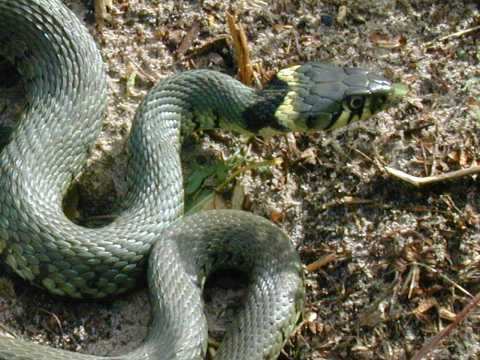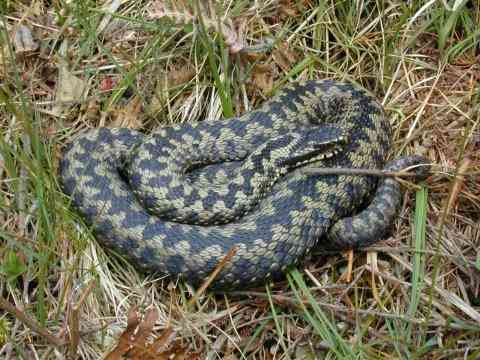
SNAKES IN THE UK
Three species of snake occur in the UK. Two of them, the grass, or ringed snake, and the smooth snake, are non-venomous, and belong to the family Colubridae. The third, the adder, or viper, is mildly venomous, and belongs to the family Viperidae.
Although snakes are now familiar as pets, they still suffer persecution. It should be stressed that none of the UK species present a serious danger to man, they are not pests, and there is no excuse for molesting these fascinating creatures. Past persecution has lead to legal protection, and killing of any reptile in the UK is now a criminal offence.
Despite the popularity of exotic snake species as pets, none of the British species make good captives. Keeping of the adder, like all vipers, is regulated under the Dangerous Wild Animals act, and this species is also an extremely poor feeder in captivity. Capture and keeping of the smooth snake is prohibited under the Wildlife and Countryside Act, due to its endangered status. The grass snake has often been kept in the past, and is occasionally kept by specialists, but its specialised food requirements preclude maintenance as a pet species.
The grass snake and adder can be very numerous in suitable habitat, and are often met with, but many reports of 'snakes' by those unfamiliar with the British species concern the slow worm. This legless lizard superficially resembles a snake, but is easily distinguished. It is not a supple as a snake, and moves more jerkily. It has a somewhat 'polished' or metallic appearance, and on closer inspection, can be seen to have closable eyelids.

Young grass snake
The grass snake is the largest UK snake, reaching up to 120cm total length. This is a relatively slender species, green, olive or brownish in colouration, with a distinct black-edged yellow or white crescent on each side of the neck. There are usually black bars along the sides, and smaller dark markings along the centre of the back. The underside is white with black chequered markings.
This species preys almost entirely on amphibians, especially the common frog, although it may eat fish or mammals on occasion. This diet means that it favours habitats suitable for amphibians, usually damp habitats, or the edge of waterbodies, and is a strong swimmer. Grass snakes also require sunny areas for basking.
The grass snake is the only egg-laying snake in the UK. The eggs require relatively high temperatures to hatch, and these temperatures are usually provided by rotting vegetation- gravid female snakes may lay their eggs in compost heaps, manure piles, or piles of sawdust. As many as 40 leathery-skinned, elongated eggs may be laid, which will take around ten weeks to hatch.
These snakes are non-venomous, and their main defence on capture is to release a foul-smelling secretion from the anal glands at the base of their tail. Severely stressed individuals may also feign death, becoming limp, lying on the back, and protruding the tongue.

Male adder
The adder is the only venomous snake in the UK. Despite this, the venom is not potent, and is not produced in quantity in this small snake, so a bite is unlikely to present a life-threatening event. However, medical attention must be sought in the event of a bite. Most bites are the result of attempts to handle these snakes, so adders SHOULD NOT be handled.
In the event of a snake bite in the UK:
DO NOT attempt to kill or capture the snake involved.
Keep calm, and try to immobilise the affected area if possible. A sling or bandage may be applied: not a tourniquet.
Seek medical attention.
DO NOT attempt other treatment, e.g. cutting the area of the bite, sucking out venom, applying a tourniquet.
Medical treatment for the bite will usually involve the administration of antihistamines. Antivenom is not generally used for adder bites, as the risk of an allergic reaction to the antivenom is greater than the risk of serious consequences of an adder bite.
Adders are small snakes, usually up to 60cm in length, but they are relatively heavy-bodied. The colouration differs between the two sexes- males tend to be lighter than females, ranging from dirty yellow to white. Females are usually much more brown or reddish. Both sexes have a dark zigzag stripe along the back, and dark bars or bars or blotches along the sides. An X- or V- shaped mark is present on top of the head. All black (melanistic) adders are occasionally found.
The main prey of adders is small mammals and other reptiles, which are killed using the venom. The adder will strike at its prey, giving a venomous bite. The prey animal will usually die in a few minutes, and the adder will track it, using its keen sense of smell.
Adders bear live young, the female giving birth to around 5 to 15 young, measuring 15-20cm. Young adders are often much more red in colouration than adults.
Adders are widespread over the whole of mainland Britain, on Anglesey, and the Isle of Wight. These snakes can be found in many open habitats, but heathland and moorland are particularly renowned as good adder habitat.
SMOOTH SNAKE Coronella austriaca
The smooth snake is a little-known and rare species in the UK. These snakes grow to around 60cm in length, and are grey or brown in colour. Two rows of dark spots occur along the back of this species, and the sides usually have spotted markings. There is usually a dark figure of eight or hourglass marking on the top of the head. Although similar in length to the adder, this snake is much more slender. The name 'smooth' relates to the scales, which do not a have a 'keel', or crease, along their centre, as in the grass snake and adder.
This snake feeds mainly on other reptiles, but may also take small mammals. It constricts its prey in a similar way to other constricting snakes such as pythons, boas and rat snakes.
Smooth snakes, like most British reptiles, bear live young. Around 5-15 young are produced, litter size depending on the size of the mother. It is thought that most female smooth snakes may breed only every other year.
Smooth snakes are extremely rare in the UK, and are protected by law. They occur only on lowland heath in Dorset, Hampshire and Surrey. They are very secretive animals, and are seen extremely infrequently. This species is threatened with extinction due to loss of suitable heathland habitat.